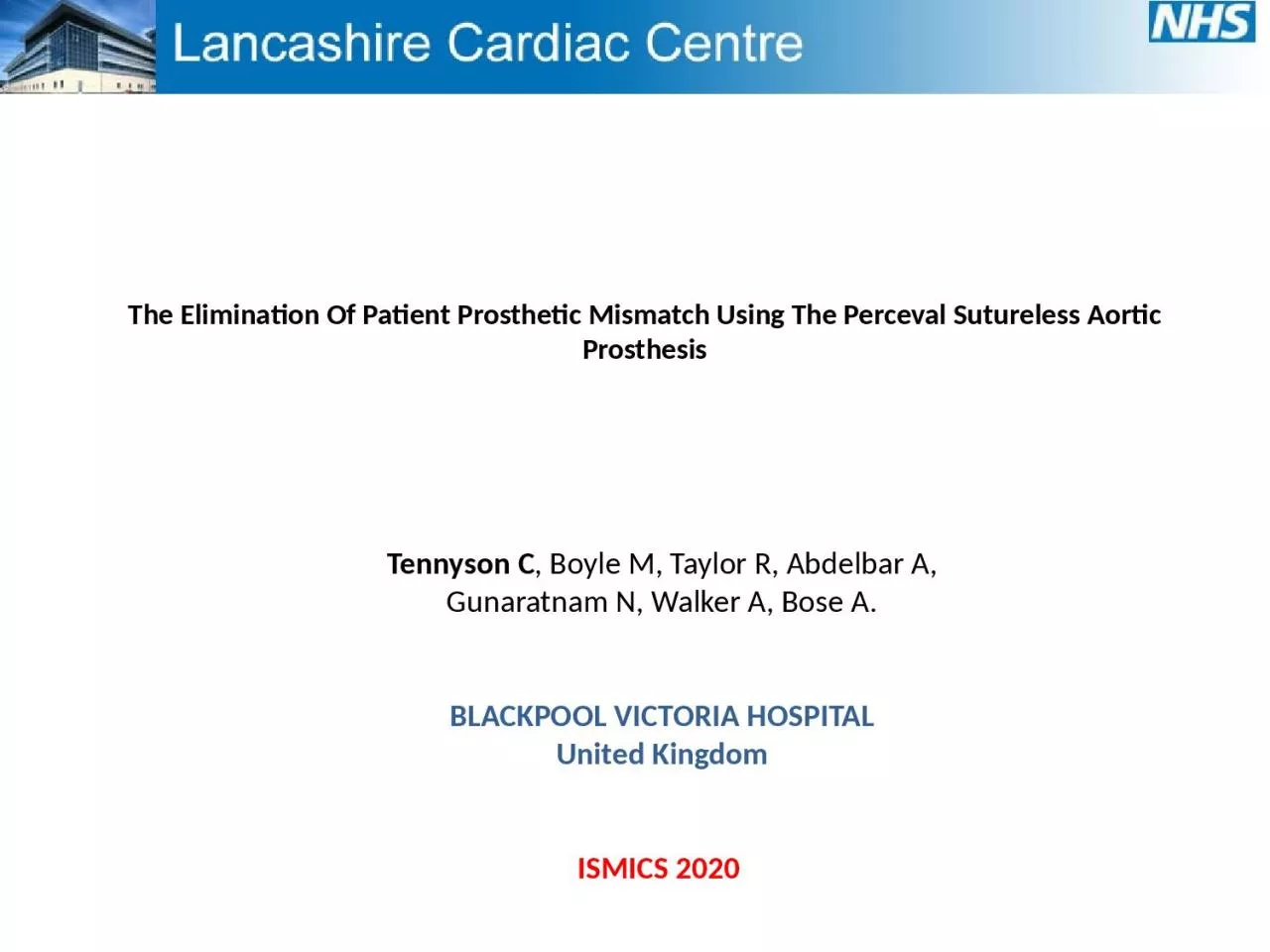

Tennyson C Boyle M Taylor R Abdelbar A Gunaratnam N Walker A Bose A BLACKPOOL VICTORIA HOSPITAL United Kingdom ISMICS 2020 METHODS Patient Prosthetic Mismatch or PPM Occurs when the effective orifice area of an implanted prosthetic valve is too small in relation to the p ID: 1028058
Download Presentation The PPT/PDF document "The Elimination Of Patient Prosthetic Mi..." is the property of its rightful owner. Permission is granted to download and print the materials on this web site for personal, non-commercial use only, and to display it on your personal computer provided you do not modify the materials and that you retain all copyright notices contained in the materials. By downloading content from our website, you accept the terms of this agreement.
1. The Elimination Of Patient Prosthetic Mismatch Using The Perceval Sutureless Aortic ProsthesisTennyson C, Boyle M, Taylor R, Abdelbar A, Gunaratnam N, Walker A, Bose A.BLACKPOOL VICTORIA HOSPITALUnited KingdomISMICS 2020
2. METHODS:Patient Prosthetic Mismatch or PPM “Occurs when the effective orifice area of an implanted prosthetic valve is too small in relation to the patient’s body service area”.
3. METHODS:Retrospective analysis of prospectively collected database2014-2019 - All patients requiring Aortic Valve Replacement, n=11781:1 Exact Matching based on BSA and sex between the Sutureless-AVR and Conventional AVR group223 matched pairs -223 Conventional AVR -223 Sutureless AVR Patient Prosthetic Mismatch PPM was defined as a projected indexed iEOA≤0.85 cm2/m2. Statistical Analysis: χ2 test , Kolmogorov-Smirnov , P-values were calculated for normally and not normally distributed variables, using a t-test and Wilcoxon signed rank test, respectively.
4. Demographics: PreoperativeParameterPerceval (n=223)Sutured (n=223)p-valueFemale (%)103 (46.2%)103 (46.2%)p=1.0BSA (m2)1.85 [1.70-2.00]1.85 [1.70-2.00]p=1.0Age (y.o.)78 [73.5-82]75 [69-79]p<0.0001Additive Euroscore8 [7-10]7 [6-9]p<0.0001Logistic Euroscore 10.7 [7.0-16.0]7.0 [4.6-12.6]p<0.0001BMI (UNITS)28.3 (4.9)27.5 (4.6)p=0.0035Pulmonary Disease (%)36 (16.1%)41 (18.4%)p=0.62Diabetes (%)40 (17.9%)31 (13.9%)p=0.29Extracardiac arteriopathy40 (17.9%)33 (14.8%)p=0.44
5. Demographics: PreoperativeParameterPerceval (n=223)Sutured (n=223)p-valueFemale (%)103 (46.2%)103 (46.2%)p=1.0BSA (m2)1.85 [1.70-2.00]1.85 [1.70-2.00]p=1.0Age (y.o.)78 [73.5-82]75 [69-79]p<0.0001Additive Euroscore8 [7-10]7 [6-9]p<0.0001Logistic Euroscore 10.7 [7.0-16.0]7.0 [4.6-12.6]p<0.0001BMI (UNITS)28.3 (4.9)27.5 (4.6)p=0.0035Pulmonary Disease (%)36 (16.1%)41 (18.4%)p=0.62Diabetes (%)40 (17.9%)31 (13.9%)p=0.29Extracardiac arteriopathy40 (17.9%)33 (14.8%)p=0.44CARDIAC FACTORSCoronary Artery Disease (%)104 (46.6%)110 (49.3%)p=0.64NYHA III-IV 120 (53.8%)94 (42.1%)p=0.0178Ejection FractionGoodFairPoor159 (65.4%)48 (19.8%)13 (5.3%)167 (68.7%)43 (17.7%)11 (4.5%)Global p=0.73
6. Demographics: IntraoperativeParameterPerceval (n=223)Sutured (n=223)p-valueMinisternotomy (%)26 (10.7%)1 converted (0.4%)N/AConcomitant CABG (%)90 (37.0%)106 (43.6%)p=0.15CPB time (min)83 [63-119.5]127 [100-153]p<0.0001XCT (min)51 [39-75]95 [74-114]p<0.0001
7. Demographics: PostoperativeParameterPerceval (n=223)Sutured (n=223)p-valueBlood Unit Transfusions (n°) 0 [0-1]0 [0-1]p=0.18AKI/dialysis5 (2.2%)3 (1.3%)p=0.72Deep Sternal Wound Infection2 (0.9%)2 (0.9%)p=1.0*Stroke or TIA7 (3.1%)8 (3.6%)p=1.0ICU stay (days)1 [1-1]1 [1-1]p=0.83Postoperative hospital stay (days) 8 [6-13]7 [6-10.5]p=0.0067Hospital death (%)5 (2.1%)7 (3.1%)p=0.7830-day mortality5/223 = 2.2%5/223 = 2.2%p=1.01 year survival176/189 = 93.1%212/223 = 95.1%p=0.532 year survival 118/134 = 88.1%154/167 = 92.2%p=0.313 year survival67/81 = 82.7%108/126 = 85.7%p=0.70
8. Effective orifice area and patient-prosthesis mismatch analysis after 1:1 matching for BSA + Sex.ParameterPerceval (n=223)Sutured (n=223)p-valueProsthesis size (mm) 25 [23-25]23 [21-25]p<0.0001EOA (cm2)2.72 [2.47-2.95]1.81 [1.69-1.87]p<0.0001iEOA (cm2/m2)1.46 [1.35-1.57]0.94 [ 0.87-1.01]p<0.0001Overall PPM (%)043 (19.3%)-Moderate PPM (%)040 (17.9%)-Severe PPM (%)03 (1.3%)-
9.
10. Kaplan-Meier Survival Estimates for Perceval and Conventional Valve Groups.log-rank test p-value of 0.30
11. CONCLUSIONSThe Perceval Sutureless prosthesis is associated with a larger indexed EOA compared to conventional valves. No cases of PPM following Perceval Sutureless valve insertion. No significant difference in mortality rates up to 3 years post-implantation despite Sutureless valve recipients having a significantly higher-risk profile. Bottom Line:Our data demonstrates the Perceval Sutureless prosthesis to be the logical valve of choice in patients with high surgical risk and in those cases with a high risk of developing PPM.